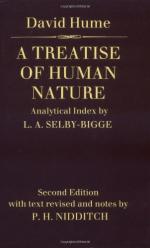
|
| Name: _________________________ | Period: ___________________ |
This test consists of 15 multiple choice questions and 5 short answer questions.
Multiple Choice Questions
1. What does Hume claim should not be arrived at instinctively?
(a) Matters of religion.
(b) Matters of love.
(c) Matters of science.
(d) Matters of fact.
2. Which of the following best describes Hume's idea of a definition?
(a) Something that is formed from our own ideas.
(b) Something that comes from the universal truth.
(c) Something we have been told as children and have grown to believe.
(d) Something that is trivially true.
3. What kind of philosophers does Hume claim are confused themselves?
(a) Ones who think but don't do.
(b) Ones who don't look beyond themselves.
(c) Ones who live and work on their own.
(d) Ones who think they have impressions about themselves.
4. What does Hume identify as the second philosophical relation?
(a) Quality.
(b) Resemblance.
(c) Space and time.
(d) Identity.
5. What does Hume say he will use to discuss passion instead of physiology?
(a) Symbolism.
(b) Experience.
(c) Psychology.
(d) Foreshadowing.
6. Why does Hume think it is impossible to believe in a God?
(a) Religion does not allow for natural thought.
(b) People have no direct impression of Him.
(c) There are too many different Gods.
(d) Religion is too strict.
7. Hume says everyone can feel the difference between what?
(a) Feeling and thinking.
(b) Impressions and ideas.
(c) Images and words.
(d) Women and men.
8. What does Hume use his razor theory to devalue?
(a) Mathematics.
(b) Reason.
(c) The imagination.
(d) Abstract concepts.
9. Hume say the human mind resolves itself into what distinct kinds ?
(a) Love and hate.
(b) Impressions and ideas.
(c) Images and words.
(d) Pride and prejudice.
10. Which French philosopher does Hume reference in this section?
(a) Sartre.
(b) Malezieu.
(c) Camus.
(d) Rimbaud.
11. From where does Hume say sensation arises?
(a) The eyes.
(b) The stomach.
(c) The soul.
(d) The spirit.
12. By what does Hume say cousins are connected?
(a) Family.
(b) Christianity.
(c) Causation.
(d) Fate.
13. Hume says impressions are divided into what?
(a) Love and hate.
(b) Pride and passions.
(c) Ideas and words.
(d) Sensation and reflexion.
14. What two cities does Hume use in his example of why it is difficult to form accurate impressions?
(a) London and Edinborough.
(b) New Jerusalem and Paris.
(c) Moscow and Prague.
(d) Glasgow and Liverpool.
15. What fruit does Hume use as an example to show our inability to form a just idea without testing it first?
(a) A pineapple.
(b) A peach.
(c) An orange.
(d) A banana.
Short Answer Questions
1. Why can pride and humility not be reduced to other passions?
2. Which is the following is the best definition of the razor principle?
3. What does Hume say is the only thing he finds when he looks inside himself?
4. What does Hume say is a disagreeable impression?
5. What kind of soul does Hume believe does not exist?
|
This section contains 510 words (approx. 2 pages at 300 words per page) |

|




